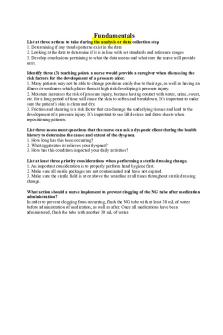Post Lecture Assignment Joshua Rupert (100740097) PDF

| Title | Post Lecture Assignment Joshua Rupert (100740097) |
|---|---|
| Author | Joshua Rupert |
| Course | Clinical Microbiology II |
| Institution | University of Ontario Institute of Technology |
| Pages | 4 |
| File Size | 61.8 KB |
| File Type | |
| Total Downloads | 334 |
| Total Views | 622 |
Summary
A Summary of Application of Next Generation Sequencing inClinical Microbiology and Infection Prevention by Deurenberg et al.Joshua RupertMedical Laboratory Science, Ontario Tech UniversityMLSC-3131, Clinical Microbiology IIHelene GouldingSeptember 19, 2021Main Text The topic of this article aims to ...
Description
1
A Summary of Application of Next Generation Sequencing in
Clinical Microbiology and Infection Prevention by Deurenberg et al.
Joshua Rupert
Medical Laboratory Science, Ontario Tech University
MLSC-3131, Clinical Microbiology II
Helene Goulding
September 19, 2021
2 Main Text The topic of this article aims to discuss the applications of next generation sequencing (NGS) in the clinical microbiology lab (Deurenberg et al., 2017). Deurenberg specifically focuses on how NGS technology can provide accurate and detailed reports on outbreak-specific and non-cultivable pathogens at the genetic level (Deurenberg et al., 2017). Traditional genetic assays such as Sanger sequencing are used to detect the presence of general types of pathogens in a patient sample through amplification of single genetic primers (Deurenberg et al., 2017). This is typically effective in pathogen identification, however these assays can struggle with complex samples containing numerous species of both normal flora and pathogens (Deurenberg et al., 2017). Many similar assays also require a subculture of the suspected organism, which is not always possible with extremely dangerous or slow growing bacteria (Deurenberg et al., 2017). These challenges can result in these assays to be unreliable in complex cases (Deurenberg et al., 2017). Deurenberg also describes how tradional molecular diagnostics cannot always identify strain-specific pathogens to predict and monitor outbreaks (Deurenberg et al., 2017). In comparison, NGS uses one standard procedure to quickly identify and sort multiple pathogens by simultaneously replicating entire genomes, providing results for more specific diagnosis and treatment (Deurenberg et al., 2017). NGS also proves advantageous in being independent of genetic primers while identifying pathogens without multiple runs or large sample volumes (Deurenberg et al., 2017). Furthermore, the NGS system developed by Deurenberg et al. was able to simultaneously correctly identify various urine sample pathogens that would have been polymerase chain reaction (PCR) negative without the use of subcultures (Deurenberg et al., 2017). Bypassing subcultures and incubation times makes NGS both time and cost effective (Deurenberg et al., 2017). Despite this, NGS proves to be disadvantageous in that it requires complex sequencing libraries needed for operation (Deurenberg et al., 2017). These libraries can be prone to error and require an operator with sufficient skills to omit errors and interpret results accordingly (Deurenberg et al., 2017). In conclusion, NGS technology
3 promises financial and time saving benefits in the clinical microbiology lab, but its application may be hindered by upfront cost and operator skill (Deurenberg et al., 2017).
4 References
Deurenberg, R. H., Bathoorn, E., Chlebowicz, M. A., Couto, N., Ferdous, M., García-Cobos, S., KooistraSmid, A. M. D., Raangs, E. C., Rosema, S., Veloo, A. C. M., Zhou, K., Friedrich, A. W., & Rossen, J. W. A. (2017). Application of next generation sequencing in clinical microbiology and infection prevention. Journal of Biotechnology, 243, 16–24. https://doi.org/10.1016/j.jbiotec.2016.12.022...
Similar Free PDFs

Assignment Joshua Shih
- 3 Pages

Post - Lecture Assignment 2:27
- 2 Pages

Trabajo Rupert Murdoch
- 11 Pages

Med Surg Post Assignment
- 2 Pages

Mental Health Post Assignment
- 2 Pages

Maternal Newborn Post Assignment
- 2 Pages

Pharmacology Post Assignment
- 2 Pages

Post Lab Assignment B
- 6 Pages

Fundamentals Post Assignment
- 1 Pages

Tenth post lecture quiz
- 5 Pages

Lab 5 Post-Lab Assignment
- 3 Pages

A10 - Joshua Farley
- 3 Pages
Popular Institutions
- Tinajero National High School - Annex
- Politeknik Caltex Riau
- Yokohama City University
- SGT University
- University of Al-Qadisiyah
- Divine Word College of Vigan
- Techniek College Rotterdam
- Universidade de Santiago
- Universiti Teknologi MARA Cawangan Johor Kampus Pasir Gudang
- Poltekkes Kemenkes Yogyakarta
- Baguio City National High School
- Colegio san marcos
- preparatoria uno
- Centro de Bachillerato Tecnológico Industrial y de Servicios No. 107
- Dalian Maritime University
- Quang Trung Secondary School
- Colegio Tecnológico en Informática
- Corporación Regional de Educación Superior
- Grupo CEDVA
- Dar Al Uloom University
- Centro de Estudios Preuniversitarios de la Universidad Nacional de Ingeniería
- 上智大学
- Aakash International School, Nuna Majara
- San Felipe Neri Catholic School
- Kang Chiao International School - New Taipei City
- Misamis Occidental National High School
- Institución Educativa Escuela Normal Juan Ladrilleros
- Kolehiyo ng Pantukan
- Batanes State College
- Instituto Continental
- Sekolah Menengah Kejuruan Kesehatan Kaltara (Tarakan)
- Colegio de La Inmaculada Concepcion - Cebu



